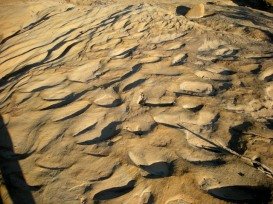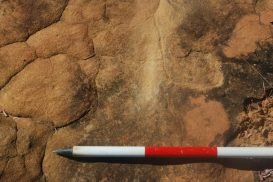Hi again groovers! Can you work out which of the following are axe grinding grooves amongst the pictures below?

1

2

3
(Images courtesy of Lynley Wallis)
To be certain we need some measurements!
Perhaps just like you as I started this investigation I thought “seen one groove, seen them all”- not so! In fact it emerges that various kinds of grooves were made by Indigenous people and that they had differing uses, including spear sharpening, ochre grinding for pigment production and seed grinding.
So how can we tell an axe grinding groove from a groove used for some other purpose, or even from a naturally occurring groove? It’s not always easy but according to the experiments over 15 years of one prominent expert, F.P. Dickson, all axe grinding grooves share certain similarities. Dickson even came up with ranges of dimensions of grooves that are suitable for axe grinding and argues that other sized grooves were unsuited for this purpose and thus reflect different usage.
So what are the dimensions characteristic of axe grinding grooves? Dickson found that they were typically 25–50 cm in length, 5–8 cm in width and 2–4cm deep at mid-length. There does exist, however, some scope for difference and margin of error; while some studies have corroborated Dickson’s findings, others have categorised grooves as axe grinding ones even when they do not fit within these parameters. In practice, there is usually some degree of subjectivity between different researchers about what constitutes the exact edge, ridge or mid-point of the groove.
As always in archaeology the contexts in which artefacts occur are crucial for providing accurate information. Axe grinding requires a substantial amount of water to act as lubricant so most axe grinding grooves are found near water sources. They also need just the right kind of hardness of rock surface, with sandstone the most suitable, typically along creek and river margins. They can also be found in rockshelters but here they will usually be fewer in number, depending largely on water and suitable surface availability.
As for natural grooves that might be mistaken for axe grinding grooves, they’re usually fairly broad, shapeless and shallow. So the first and third pictures above are of axe grinding grooves, while that in the middle is of a grinding surface used for some other purpose, perhaps seed grinding!
Now it’s “back to the grind” for me – keep an eye on this blog in the near future for a look at some of the edge-ground axes that made these grooves!
And for those of you who want to learn more about Dickson’s seminal research into axe grinding grooves, here are the references for his key papers on the topic:
Dickson, F.P. 1976 Australian ground stone hatchets: Their design and dynamics. Australian Archaeology 5:33–38.
Dickson, F.P. 1980 Making ground stone tools. Archaeology and Physical Anthropology in Oceania 15:162–167.
Dickson, F.P. 1981 Australian Stone Hatchets: A Study in Design and Dynamics. Sydney: Academic Press.

